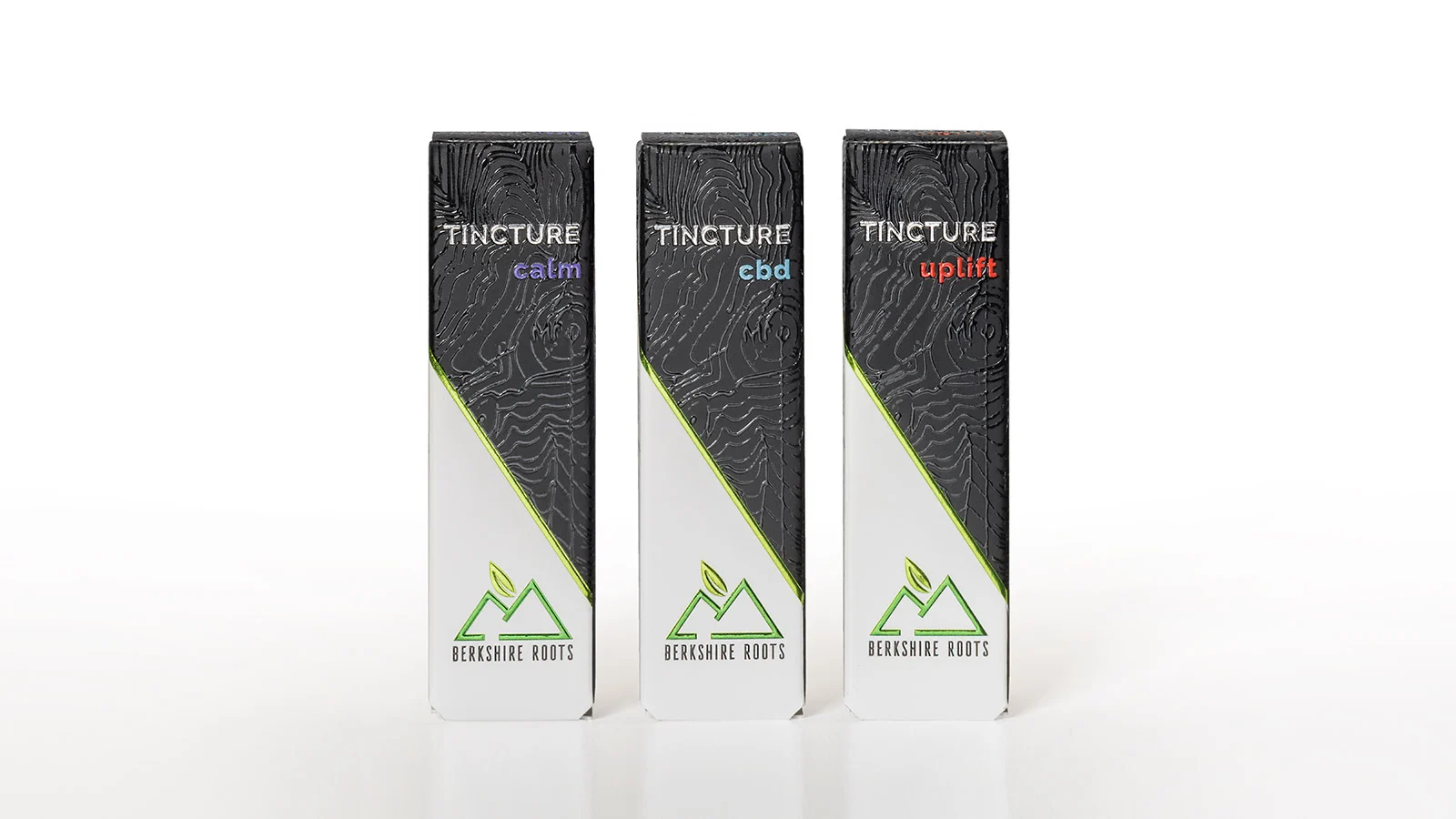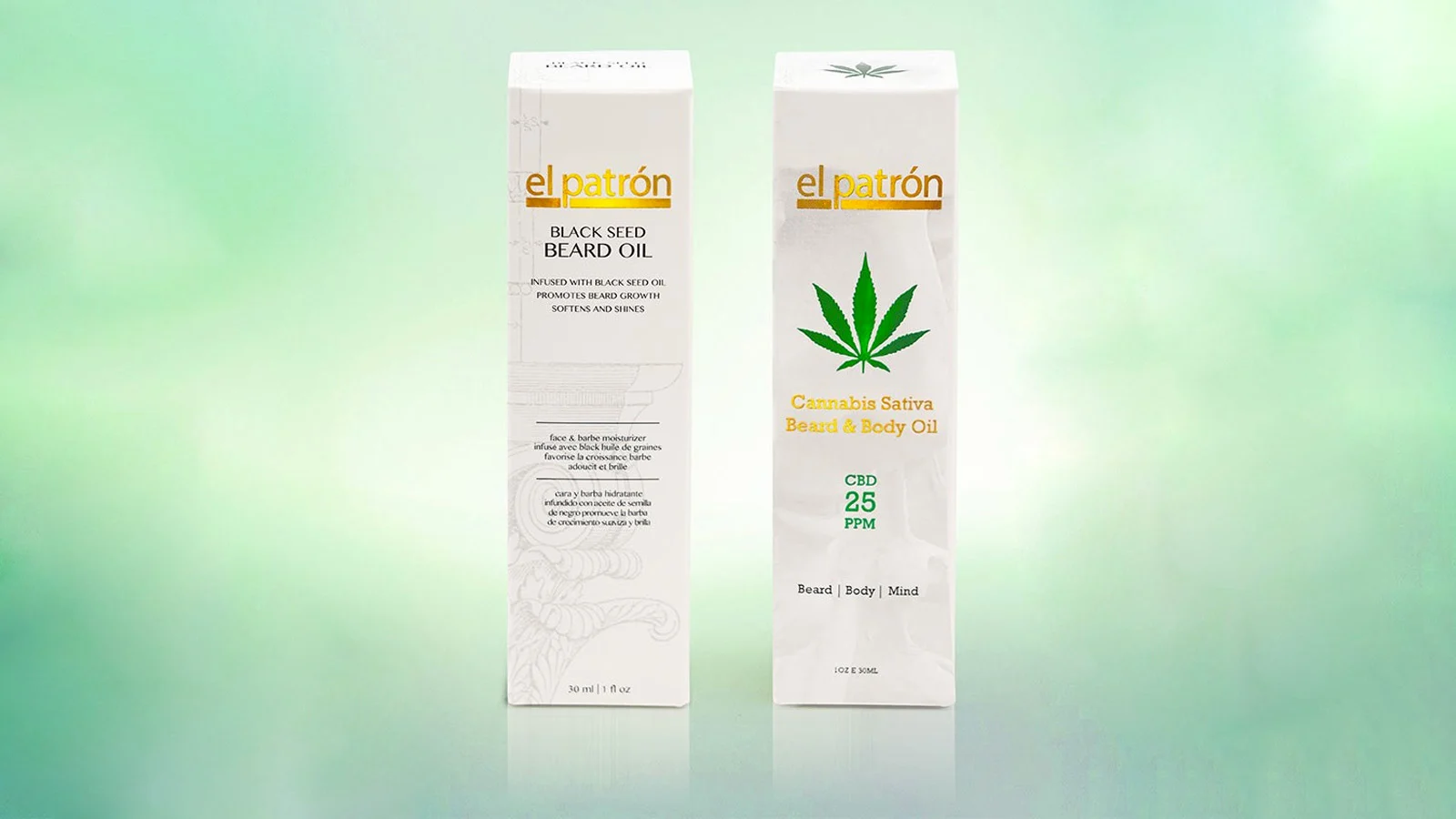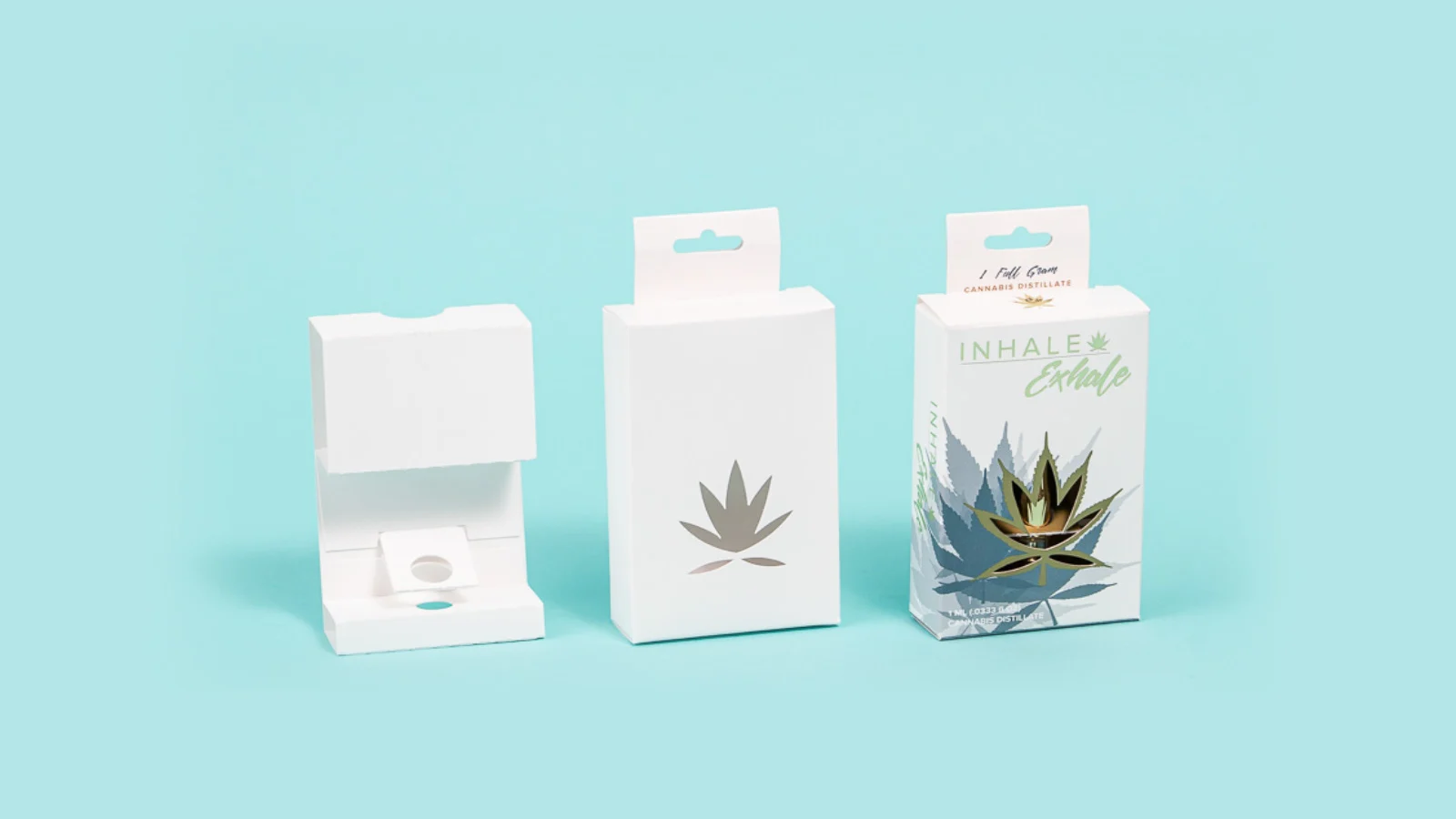The Oliver Guide to Cannabis Packaging

Introduction
We are in the early years of the cannabis industry. While many regulations have been put in place for the production and sale of cannabis products, packaging norms are much more in flux.
Many brands have turned toward more the earthy and relaxed nature of the product, while others are experimenting with high-end branding visuals. Either can be successful—if done right.
From sustainability and material selection to decorative effects and labeling requirements, this guide provides an overview of the major elements that go into effective cannabis packaging.
Packaging Regulations & Labeling Requirements
Cannabis brands have to carefully combine packaging regulations and labeling requirements with effective branding—perhaps more than any other industry, alongside pharmaceuticals. This requires compliance with local, state, and federal laws.
Although you’ll want to consult the regulations in your particular state, Leafly, a website committed to cannabis education and safe consumption, has created this convenient guide outlining some of the laws and regulations in each where cannabis is legal.
Commonalities certainly exist across the United States, but each state has its own quirks and approaches. For example, California does not permit cannabis brands to market to people under 21—prohibiting cartoons, candy-like features, and the image and likeness of characters or phrases popular among children.
Most states also do not allow cannabis brands to assert their products provide any health benefits, physical or otherwise.
For consumer safety, THC and CBD products are required to feature essential information such as ingredients, health risks, warnings, proper dosage, and a batch number or barcode to designate where items are manufactured and sourced.

Display or Storage of Cannabis Products
Another way cannabis products are unique to most other industries rests in the way they’re stored and displayed to the public. For instance, in Washington State, as in most, cannabis products are required to remain stored behind a counter or similar display so that consumers cannot directly access them without assistance from retail employees.
This being the case, smart cannabis brands are quick to focus on how their products look in glass display cases, and not just in the hands of consumers. This is where attention-grabbing visuals and memorable box designs help brands stand out among their competitors. Whether display shelves are perfectly transparent or retain a dusty veneer, your cannabis products must find a way to shine through the haze.
Consumers will eventually have a chance to physically handle your products, but your packaging better attract some eyeballs first.
Child-Resistant Features & Anti-Counterfeit Packaging
Sure, cannabis products such as THC and CBD are typically required to remain behind protective display glass or other similar shelves, but many states expect your items to have child-resistant features, as well.
Be certain packaging accounts for this at both the secondary and primary levels. This can be accomplished with difficult-to-open or other tamper-proof measures, including heat-sealed labels and avoiding easy-open tabs.
But you also need to keep your products safe from criminals and counterfeits. Someone may attempt to put their products in your packaging, or imitate yours. Not only can this undermine your brand reputation, but it also puts consumers at risk.
Illegitimate products may contain unsafe ingredients, and whether a consumer’s physical reaction is minor or severe, they will likely not know yours was compromised—leaving them to believe their bad experience is a reflection of your brand and not illicit activities.
To counteract this, brands employ anti-counterfeit packaging, in the form of covert and overt authentication solutions.
Overt Authentication Solutions
Discernable with an unaided eye, overt authentication solutions are still difficult for criminals to replicate.
These include color-shifting inks that change in light depending on viewing angle, pearlescent inks with a unique shine recognizable to legitimate retailers and manufacturers, and holographic seals and labels difficult to reproduce without sophisticated printing technology.
It’s also common for cannabis products to use specialized 2D and QR codes for tracking authentic merchandise.
Covert Authentication Solutions
Using more advanced tools, covert authentication solutions are invisible to the naked eye.
These include UV and infrared light-reactive inks readable with accompanying technology, hidden indicia ink made visible with a special lens and decoding software, thermochromic inks verified when enduring extreme temperature changes, and Digimarc barcodes and digital watermarking with hidden images discernible only through specifically calibrated devices.

Decorative Effects & Packaging Materials
The most charismatic aspects of cannabis packaging are the materials and decorative effects themselves. These are usually what consumers think about when recalling the impact a cannabis product’s packaging had on them.
Furthermore, packaging must secure and protect your products while attracting consumer attention—all while resting inside display cases. This is where decorative effects and material choice comes into play.
Let’s unpack what that means for cannabis and CBD packaging.
Coatings & Laminates
Contributing added resistance to tears and abrasions, coatings and laminates also provide dramatic shine to cannabis products.
While glossy finishes epitomize iridescence and sheen, matte finishes provide a glistening quality that absorbs rather than reflects light.
Leaning toward the sensible, tactile coatings employ lifted or textured surfaces, inviting consumers to hold and handle products longer—giving your brand an opportunity to leave a lasting impression
Pearlescent inks amplify your packaging’s shimmer by integrating small, reflective bits into clear UV coatings.
Additionally, strike-through and reticulating varnishes give packaging unparalleled rub resistance, while retaining high-shine quality.
Hot Foil Stamping
A heat-based method, hot foil stamping applies metallic foil to substrates. Foil, of any color, is spread over the substrate opposite a counterplate. Then, a custom die hammers down with heat, applying the foil to the desired area. Excess foil is peeled away, leaving behind a beautiful finish that communicates luxury or premium quality.
Cold Foil
Although it similarly adheres foil to a substrate, cold foil relies on ultraviolet light instead of heat to apply metallic material to a substrate. Additionally, cold foil colors can pull from across both the CMYK and PMS spectrums, giving brands nearly endless pigment possibilities.
Debossing/Embossing
Designed to give visual elements three-dimensional traits, embossing raises any design feature from the rest of the substrate, while debossing lowers it. Both are effective at drawing attention to your cannabis products.
Materials
Tinctures, folding cartons, and capsule boxes remain the standard for cannabis packaging structure. While most frequently made of paperboard, more and more brands are turning to alternative renewable materials (more on this below). The materials you choose should reflect your brand.
Furthermore, you must be certain your packaging materials combine well with desired decorative effects. Some inks and finishes work better with other materials. Plus, some are more adaptive to folding and abrasions than others. So before you commit to a large print run of cannabis packaging, produce a short run of samples.
An experienced printing and packaging manufacturer can guide you on which factors are most important to consider when choosing materials.

Eco-Friendly Cannabis Packaging
Leaders in the cannabis industry are committed to sustainable packaging, not only because of the positive environmental impact, but to meet the demands of a growing number of eco-conscious consumers that want brands to reflect their deeply held values.
Eco-friendly cannabis packaging is about reducing your environmental impact at every phase of the printing and packaging process, from the energy sources used to transport and store materials, to the ways materials are sourced and implemented in packaging.
A sustainable cannabis brand will adopt right-size packaging principles, lower its carbon footprint, localize supply chains, source from responsibly managed forests, and implement tree-free alternatives when appropriate.
Right-Size Packaging
At the most basic level, packaging aims to preserve and protect products. Right-size packaging maintains these functions while eliminating any unnecessary materials. It’s about cutting back on waste—think of what consumers do with your packaging once they’ve opened a cannabis product.
But it also reduces shipping costs, because you’re no longer paying to ship what amounts to superfluous air pockets or excessive paper layers. This also minimizes how much weight you’re shipping, thus shrinking your carbon footprint.
Consumers notice which cannabis brands are the biggest offenders when it comes to unnecessary packaging. Each additional piece of plastic wrap or paper they unpackage can really weigh on their conscience. These added layers taint the unboxing experience, leading consumers to associate your brand with unpleasant feelings.
Alternatively, if they feel like they’re making an eco-friendly choice by purchasing your product, they’re much more likely to come back.
Lowering Your Carbon Footprint
Given the catastrophic impacts of climate change, reducing your carbon footprint (among other greenhouse gasses) is the best thing a brand can do to become more sustainable.
Examine each phase of your operations, identifying places where you can reduce emissions. This can include switching to more renewable energy sources, shortening supply chains, collaborating with third parties that run more sustainably, and reducing the use of petroleum-based products, such as plastics, for example.
Localizing Your Supply Chain
As you might surmise, localizing your supply chain is a quick way to reduce carbon emissions. By reducing the miles your products and packaging materials travel, you shrink your carbon footprint. It makes environmental sense, but there’s also a business case to be made for localizing your supply chain.
Sourcing From Responsibly Managed Forests
Paper continues to be the most popular substrate material for cannabis brands. If you want to be eco-friendly, ensure your timber is sourced from responsibly managed forests. Printing and packaging partners who use paper derived from environmentally friendly foresting are usually certified by one of a few organizations: the nonprofit Forest Stewardship Council (FSC), Sustainable Forest Initiative (SFI), or Programme for the Endorsement of Forest Certification (PEFC).
Tree-Free Alternatives
While paperboard is a fantastic and renewable packaging substrate material, other sustainable alternatives have entered the market in recent years. These include tree-free alternatives such as hemp, casein, sugarcane bagasse, and other biodegradable options.
Cotton and post-consumer recycled paper are worthwhile candidates, as well.
Notably, some of these alternatives, such as cotton and hemp, require a small degree of paper filler to become sturdy enough to serve as folding carton material. Consult with your packaging partner to determine which sustainable packaging materials best suit your needs.
The formal cannabis industry is relatively young, and going green is one way your brand can stand out among steep competition. Some brands are also embracing premium or luxury branding to gain an edge.

Premium Packaging for Cannabis Brands
It’s common for many cannabis brands to emphasize their casual, laid-back, and earthy values. As an extension of that, some have integrated natural tones into their design, and even used hemp in their packaging. While this has obviously proven to be a successful strategy, other brands are branching out, adopting visual styles more popular in luxury food and health and beauty brands.
One such brand is Inhale Exhale, who recently partnered with Professional Image, now a member of the Oliver Inc. family.
When Ryan Day founded the premium cannabis distillate company Inhale Exhale, he wanted to embrace a brand design that would contrast with the more lowbrow brands in the cannabis market.
“My design philosophy is simplicity,” Day says, commenting on his approach to branding. “It’s more sophisticated and mature than a lot of companies in the cannabis industry who go with that ‘stoner look.’ I don’t think that’s what the industry needs to get the respect it deserves.”
To signal its premium quality to consumers, Inhale Exhale integrated gold foil stamping, debossing/embossing, and other elegant design visuals. Day believes Inhale Exhale’s widely positive reception is largely due, in part, to the thoughtful approach they took to visuals and packaging design.




